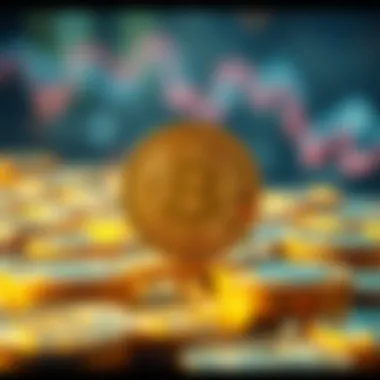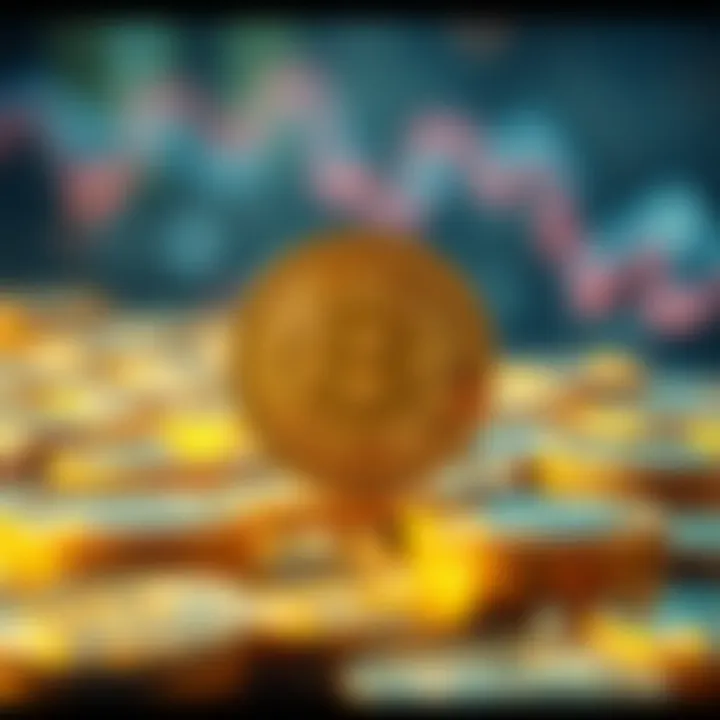A Complete Guide to Buying Non-Fungible Tokens


Intro
The world of digital assets has taken a wild turn, capturing the interest of investors and tech enthusiasts alike. Among these assets, non-fungible tokens (NFTs) have emerged as a notable component, not easily defined or understood by the casual observer. This guide aims to shed light on the process of acquiring NFTs, crucial for anyone wanting to wade into these waters. With the rise of digital ownership and provenance, understanding the basics of cryptocurrency and the platforms available for trading NFTs is key.
In this article, we'll cover fundamental concepts of cryptocurrencies, delve into the mechanics of blockchain technology, and discuss various investment strategies tailored for both novice and seasoned investors. By the end, you will have a clearer framework for navigating the sometimes murky waters of NFT investments.
Understanding Cryptocurrency Basics
What is Cryptocurrency?
Cryptocurrency, at its core, represents a form of digital or virtual currency. Unlike traditional coins or paper bills, cryptocurrencies are decentralized and built on blockchain technology, ensuring a level of security and transparency not seen in conventional finance. Each transaction is recorded on a public ledger, making it exceedingly challenging to counterfeit or double-spend these digital assets.
For those curious about specific examples, popular cryptocurrencies such as Bitcoin, Ethereum, and Litecoin are frequently cited in discussions. A notable aspect of cryptocurrencies is that they operate independently of a central authority, letting users trade directly and often at lower fees, which can be quite beneficial.
How Does Blockchain Technology Work?
Understanding blockchain is crucial when delving into NFTs. Essentially, a blockchain is a digital ledger that records all transactions across a network of computers. Every block in this chain contains a number of transactions, and once a block is filled, it is closed and linked to the previous block, forming a chain.
Here’s what makes blockchain stand out:
- Transparency: All participants can view the entire history of transactions, fostering trust among users.
- Immutability: Once recorded, it’s virtually impossible to alter any detail from the blocks without a majority consensus, making fraud incredibly difficult.
- Decentralization: No single entity controls the entire network, which helps to prevent data tampering.
"The strength of blockchain technology lies in its decentralized and transparent nature, revolutionizing how we perceive trust in digital transactions."
These features provide a solid backbone for NFTs, as they leverage this technology to establish provenance and ownership of digital items, whether it's artwork, music, or virtual real estate.
With these basics in place, let's transition into investment strategies in the crypto landscape, including how to effectively position yourself in acquiring NFTs.
Preamble to Non-Fungible Tokens
Understanding non-fungible tokens, commonly known as NFTs, is essential for anyone looking to navigate the modern digital assets landscape. As unique digital items, NFTs have transformed how we perceive ownership and value in the virtual realm. In a world where traditional assets like stocks and real estate have been the mainstays of investment, NFTs offer something distinctly different: individuality.
Definition of Non-Fungible Tokens
Non-fungible tokens are a type of digital asset that represents ownership of a singular item or piece of content on the blockchain. Unlike cryptocurrencies such as Bitcoin or Ethereum, which are fungible and can be exchanged for one another at the same value, each NFT is unique and not interchangeable. This uniqueness is what gives NFTs their value; they can represent anything from digital art and music to virtual real estate and gaming assets. In essence, an NFT is a certificate of authenticity and ownership, permanently recorded on the blockchain for transparent verification.
Comparison with Traditional Assets
To grasp the significance of NFTs, it's helpful to compare them to traditional assets. Unlike stocks, bonds, or commodities that can be substituted for one another without loss of value, NFTs stand alone. At their core, the distinction lies in their perceived value: traditional assets often rely on market demand and economic indicators, while NFTs draw value largely from rarity and provenance. Consider the following aspects:
- Market Valuation: Traditional assets have established markets with prices driven by supply and demand. In contrast, the NFT market is more subjective, heavily influenced by trends, creator reputation, and community sentiment.
- Ownership Rights: Purchasing traditional assets like real estate typically grants you rights recognized by legal systems. For NFTs, ownership is tracked on the blockchain, yet rights can vary; some NFTs come with usage rights, while others offer none.
- Liquidity: Liquidating traditional assets can take time due to legalities and market conditions. NFTs may offer quicker transactions on platforms, but the liquidity can be highly variable depending on the type and demand for the item.
When examining these differences, it's crucial to recognize the opportunities and risks that NFTs present. They allow for a direct connection between creators and consumers, democratizing access to art and collectibles. However, the volatility and speculative nature of the NFT market can also pose significant challenges.
By grasping these fundamental concepts, readers can better understand the labyrinth of NFTs and their role in the evolving economic landscape. This understanding will be foundational as we explore the technology that underpins NFTs and how to effectively participate in this intricate market.
Understanding the Technology Behind NFTs
Understanding the technology behind non-fungible tokens (NFTs) is crucial for comprehending their significance in today's digital landscape. At the heart of NFTs lies a unique combination of blockchain technology and smart contracts, both of which bring forth the core functionalities and benefits of these digital assets.
For anyone looking to invest in or create NFTs, grasping these concepts can make the difference between success and stumbling in the dark. The blockchain serves as a decentralized ledger, providing transparency and security. By utilizing this technology, NFTs can assert their uniqueness and ownership without the interference of third parties. This ensures that when you purchase an NFT, it's truly one of a kind, and you hold exclusive rights over it.
Moreover, smart contracts automate various actions related to the trading of NFTs. They govern the terms, ensuring that when a transaction occurs, it is executed flawlessly. Understanding these foundational components allows investors and creators to fully embrace the potential of NFTs, making informed decisions on which assets to acquire or develop.
Blockchain Fundamentals
Blockchain technology essentially acts as the backbone of NFTs. Imagine blockchain as a digital vault, where every transaction is recorded like a chain of blocks. Each block holds information about transactions, timestamps, and cryptographic hashes. This structure guarantees that once data is added to the blockchain, it can't be altered, creating a permanent and immutable record.
What makes blockchain invaluable for NFTs is its decentralized nature. Unlike traditional databases controlled by central authorities, the blockchain is operated by a network of computers, making it resistant to fraud and tampering. In addition:
- Transparency: Every transaction can be viewed by anyone, ensuring complete openness in the ownership history of an NFT.
- Security: The use of cryptography protects the data, making unauthorized changes nearly impossible.
- Interoperability: Different platforms can utilize the same NFT standards, allowing them to be traded across multiple marketplaces seamlessly.
This leads to a vibrant ecosystem where NFT creators and buyers can engage with confidence, building trust in the very fabric of digital ownership.
Smart Contracts Explained
In the realm of NFTs, smart contracts function as automated, self-executing agreements coded onto the blockchain. They're akin to digital vending machines: once you input the right tokens (or data), you get a predetermined outcome—in this case, it could be the transfer of an NFT.
Smart contracts facilitate numerous functionalities, such as:
- Condition Fulfillment: They ensure that specified conditions are met before executing transactions, thus eliminating the risk of human error.
- Royalties: Creators can code royalty payments directly into the contract. This means every time the NFT is sold, a percentage goes back to the original artist.
- Ownership Verification: Each NFT comes with its own metadata stored in the smart contract, which details its history and authenticity.
By utilizing smart contracts, investors and creators can ensure a smoother transaction process and maintain rights and interests over their digital creations. Understanding this technology not only helps in navigating the NFT landscape but also empowers individuals to participate innovatively in this rapidly evolving market.
"Blockchain technology empowers creators and investors to engage directly, sidestepping traditional gatekeepers, thus redefining ownership in the digital era."
In summary, grasping the fundamentals of blockchain and smart contracts is imperative for anyone interested in the NFT market. It opens the door to both the potential rewards and challenges that come with investing in non-fungible tokens.


Types of NFTs and Their Uses
Understanding the various types of non-fungible tokens (NFTs) is crucial for anyone navigating the digital marketplace. NFTs serve more than just the aesthetic value of digital art; their applications are vast, encompassing different sectors like entertainment, real estate, and gaming. By recognizing the uses of NFTs, investors can target particular areas that align with their interests or investment strategies.
Digital Art and Collectibles
Digital art has surged in popularity, with artists leveraging NFTs to gain rightful ownership and monetary recognition for their work. Unlike traditional art that may rely on galleries for exposure, artists can directly sell their pieces as NFTs on platforms like OpenSea or Rarible.
For collectors, purchasing digital art NFTs represents ownership of unique, verifiable assets. Each artwork is embedded with metadata that confirms its origin and authenticity, making it easier for collectors to prove they own a genuine piece. This use goes beyond merely flaunting ownership; it’s about linking creators and fans in a transparent manner.
Consider the case of digital artist Beeple, whose work sold for $69 million at a Christie’s auction. This event highlighted how digital art could reach astronomical values—a stark contrast to the often-misunderstood perception of intangible assets. As a reminder:
"Art is not what you see, but what you make others see."
Virtual Real Estate
The concept of virtual real estate is another intriguing area where NFTs come into play. Spaces in virtual worlds, like Decentraland or The Sandbox, can be bought, sold, and developed, and these transactions occur via NFTs. Think of it as purchasing a digital square of land where you can build structures, host events, or even create virtual stores.
Investors often see virtual real estate as an emerging market ripe for growth, particularly as technology advances and virtual experiences become more commonplace. Owning digital land means you are not just hodling; you buy potential—a concept that, surprisingly, mirrors real-world real estate values. The advantage here is the ease with which potential owners can auction off their plots or rent them out to others, creating additional revenue streams. This shift in view highlights the expansive utility of NFTs beyond traditional frameworks.
Gaming Applications
Gaming is another field where NFTs have found a warm reception. Gamers are now able to acquire in-game assets as NFTs. This allows them to truly own their skins, weapons, characters, and more, which can then be traded or sold to others. Titles like Axie Infinity illustrate how this function operates by allowing players to earn money through gameplay—an innovative shift from typical game economics.
These assets can vary greatly—ranging from rare swords in a fantasy universe to unique characters in an open-world game. By owning in-game items as NFTs, players gain control over their items, creating real-world value from virtual interactions.
Investors looking to enter this market must consider the community’s engagement, the rarity of the items, and future expansions of the game. As gaming continues its evolution, the prospect for NFTs in this landscape appears promising.
Understanding these types of NFTs and their uses not only informs purchasing decisions but empowers potential investors to think strategically about the implications of their investments. Recognizing the growing acceptance of NFTs across diverse sectors means embracing an interactive and transformative element of today's digital economy.
Choosing the Right NFT Marketplaces
When it comes to diving headfirst into the world of NFTs, choosing the right marketplace can be the difference between hitting the jackpot and rubbing elbows with regrettable decisions. The platforms available for buying and selling NFTs come with their own unique attributes and intricacies. This guide will help investors sift through the murky waters of digital marketplaces to pin down the one that fits their goals.
Overview of Popular Platforms
There is no shortage of NFT marketplaces, each boasting its distinct flavor and specialties. Some platforms cater specifically to art, while others might focus on gaming assets or virtual real estate. Here’s a rundown of some of the most recognized marketplaces:
- OpenSea: Often heralded as the behemoth of NFT marketplaces, OpenSea offers a wide array of categories, making it a one-stop shop for digital assets. Their user-friendly interface appeals both to novices and seasoned collectors.
- Rarible: More than just a marketplace, Rarible empowers users with governance tokens, creating a community-centric environment. It’s particularly known for artists and content creators seeking to establish a voice in the NFT realm.
- Foundation: This platform focuses on showcasing high-quality digital art. Foundation operates on an invite-only basis, ensuring a level of exclusivity that attracts curated artists.
- SuperRare: Similar to Foundation, SuperRare highlights unique artworks but emphasizes the rarity and collectibility of each piece. It's a great spot for those looking to invest in limited edition art pieces.
- Nifty Gateway: Known for hosting drops with high-profile artists, Nifty Gateway allows purchases with credit cards, making it accessible to those unfamiliar with cryptocurrency.
In evaluating these options, consider what type of NFTs you are interested in. Each marketplace has its own set of users and spirit, thus influencing pricing, community interaction, and transaction experiences.
Decentralized vs. Centralized Markets
Before diving into buying NFTs, understanding the distinctions between decentralized and centralized marketplaces is paramount. Each type operates on varied principles and can significantly affect your purchasing experience.
- Centralized Markets: These platforms function under a centralized authority, which can facilitate smooth transactions but may come with drawbacks such as higher fees and potential restrictions. Think of it like a traditional art gallery where a curator decides what enters the space. The pros are that centralized marketplaces often provide greater user support and generally attract more buyers due to their established reputation. Platforms like Nifty Gateway and Rarible can be categorized here.
- Decentralized Markets: In contrast to their centralized counterparts, decentralized marketplaces operate on blockchain technology, which allows for peer-to-peer transactions. This model fosters more transparency and grants users greater control over their assets. OpenSea stands out in this realm, serving as a non-custodial marketplace where users maintain ownership of their digital assets without an intermediary. The downside may be the steeper learning curve for first-timers and potentially higher volatility.
In the end, the choice between decentralized and centralized markets boils down to personal preferences and objectives. Are you looking for a wider variety of assets or do you prioritize user experience and support? The former typically aligns with decentralized options, while the latter is often found in centralized platforms.
Important Note: Always read the fine print when it comes to platform fees and policies; this can be the make-or-break factor in your buying experience.
Establishing a Digital Wallet
In the landscape of non-fungible tokens, establishing a digital wallet is not just a necessary step; it’s the keystone of your experience as a buyer and collector. Think of it this way: without a wallet, your ability to store, transfer, and manage your NFTs is akin to trying to run a marathon without shoes. The importance of this element can’t be overstated.
A digital wallet functions as the bridge between your traditional finances and the crypto world. It enables you to interact with NFT marketplaces, facilitating the purchase and sale of digital assets. Let’s break it down further.
Types of Wallets
There are primarily two types of wallets that investors should consider:
Hot Wallets
A hot wallet refers to any wallet that is connected to the internet. The immediate advantage is convenience. It allows for rapid transactions, which is crucial in the fast-paced NFT market. Almost like having cash in your pocket, you can access your assets from anywhere at any time.
- Key Characteristic: Hot wallets are user-friendly, with interfaces that cater to both veterans and newcomers alike.
- Why It's Beneficial: Their ease of use can entice beginners who might feel daunted by the prospect of investing in NFTs.
- Unique Features: Many hot wallets come with integrated exchange capabilities, meaning you can buy or swap coins directly within the app without needing an additional platform.
However, like leaving your front door open, hot wallets do come with some risks due to their constant internet availability. They are more susceptible to hacking and phishing attempts, making it crucial to practice vigilance.
Cold Wallets
On the opposite end, cold wallets provide a level of security that hot wallets simply can't match. These wallets store your cryptocurrencies offline, significantly reducing the risk of cyber theft. Think of them as your safe deposit box in a bank—great for assets you plan to hold for the long haul.
- Key Characteristic: Cold wallets stand out for their security properties, designed primarily to keep your assets safe.
- Why It's Popular: Many seasoned investors who prioritize asset security prefer cold wallets for large, long-term holdings.
- Unique Feature: The fact that cold wallets are offline means they can't be accessed by online threats, offering peace of mind.
However, the trade-off involves a bit more complexity and slower transaction times. Accessing your NFTs requires a few more steps, which might not sit well for someone used to instant gratification.
Setting Up Your Wallet


Setting up your wallet is a relatively straightforward process but it does require attention to detail. Here are some steps you can follow:
- Choose a wallet provider: Research options that fit your needs, weighing pros and cons of both hot and cold wallets. Examples include MetaMask and Ledger.
- Download or order your wallet: For hot wallets, download the app; for cold wallets, place an order and follow the instructions included.
- Create an account: Input the necessary information and set a strong password. A password manager can help you keep track!
- Backup: Make sure to write down your recovery seed phrase and store it in a safe place. This is often a one-time chance to retrieve your wallet in case of loss.
- Testing: Before loading it with significant funds, it’s a good idea to run a couple of transactions with smaller amounts to make sure everything operates smoothly.
Establishing a digital wallet is not only a security measure but also paves the path to diving into the NFT world with confidence. As you move on to explore NFT marketplaces, having a reliable and secure wallet in place will help ensure your valuable digital assets are well-protected.
How to Purchase NFTs Step-by-Step
Navigating the world of non-fungible tokens can seem daunting, especially for newcomers. The process of purchasing NFTs is critical to understand, as it involves several steps that ensure you can enter the market safely and efficiently. Having a structured approach allows for informed decision-making, which can greatly influence your investment outcome.
Funding Your Wallet
Before jumping into the vibrant world of NFTs, you need to prioritize funding your digital wallet. This is the essential first step, as you cannot purchase NFTs without having funds at your disposal. Most NFT marketplaces do not accept traditional payment methods directly. Instead, they require you to use cryptocurrency, generally Ethereum, which dominates the NFT space.
To fund your wallet, follow these key steps:
- Select a Cryptocurrency Exchange: Choose a reputable exchange. Some popular options include Coinbase, Kraken, and Binance. Ensure the platform of your choice supports Ethereum.
- Create and Verify Your Account: After selecting your exchange, sign up and complete the required identity verification process, which is oftentimes a standard procedure for security.
- Deposit Funds: Transfer traditional currency to your exchange account. You can usually do this via a bank transfer or credit card.
- Buy Ethereum: Once your deposit is complete, navigate to the cryptocurrency section of from where you can purchase Ethereum. Confirm your transaction and wait for the process to finalize.
- Transfer Ethereum to Your Wallet: Finally, once bought, send your Ethereum to your established digital wallet. Be careful to enter the wallet address correctly; a simple mistake can lead to irreversible losses.
Searching for Desired NFTs
Once your wallet is funded, the next step is searching for NFTs that pique your interest. With thousands of options out there, knowing how to effectively filter through choices is key. It’s essential to ask yourself what kind of NFT you’re interested in: digital art, virtual real estate, or collectibles?
Here’s how to navigate this:
- Explore Various Marketplaces: Platforms such as OpenSea, Rarible, and Foundation are popular locations to explore. Each has its own distinguishable features and specialties, so take some time to visit them all.
- Use Filters: Most platforms come equipped with filters for price, type, or even popularity. This can help you track down what you are looking for without getting lost in a sea of options.
- Research Artists and Creators: Take a moment to look into the history and reputation of the NFT creators. Established artists may have a proven track record, which could potentially make their NFT more valuable.
- Follow Trends: Keep an eye on forums such as Reddit and Twitter. These platforms often have the latest buzz on trending NFTs and hot creators. Joining communities can provide insights you might not find elsewhere.
Placing a Bid vs. Buying Instantaneously
When you’ve located the NFT you want, the next decision is how you want to purchase it: through an instantaneous buy or placing a bid. Understanding the pros and cons of each option will shape how you approach your purchase.
- Instantaneous Buy: This option allows you to purchase the NFT without delay at a fixed price set by the seller. The immediate nature of this method can be comforting, especially if you're targeting a popular NFT. However, be aware that prices can be higher than auctioned ones.
- Placing a Bid: Here, you offer a certain amount in hopes of winning the NFT from an auction. This can be less predictable since it depends on the competition from other buyers, as well as timing. You might snag a bargain if you're willing to wait, but you also run the risk of losing the asset to a higher bidder.
When making your choice, assess your budget, how much you value the NFT, and time. If your heart is set on a particular piece, an instantaneous buy might save you from losing it to other buyers.
The journey of purchasing NFTs isn’t just transactional; it’s an experience that combines art, technology, and finance in an immersive way .
In closing, taking the proper steps to fund your wallet, searching thoughtfully, and understanding your buying options allows you to dive into the NFT sea with confidence. Each decision can pave the way for your future successes in the digital realm.
Verifying Authenticity and Ownership
In the vast ocean of digital assets, non-fungible tokens (NFTs) stand out as unique pieces of art, collectibles, and property. However, this uniqueness introduces a challenge—how can one verify that an NFT is authentic and that the ownership is indeed legitimate? Diving into the importance of verifying authenticity and ownership is essential for ensuring that your investment holds value. This section will break down the need for rigorous checks and understanding provenance, alongside methods to utilize external verification tools.
Understanding Provenance
Provenance refers to the history of ownership of an art piece or collectible, and in the realm of NFTs, it plays a central role. It’s not just about who owns the NFT now; it’s about understanding the complete journey of that token. For collectors and investors alike, knowing the provenance can mean the difference between paying top dollar for a sought-after piece or falling prey to fraud.
For example, consider a digital artwork sold as an NFT. If this piece has a documented history showing it was created by a renowned artist and passed through the hands of notable collectors, its value skyrockets. Conversely, a similar image without a credible history could be worthless.
Here are some key points to keep in mind when examining provenance:
- Creator Verification: Ensure that the NFT has been minted by its original creator, preferably via a secure platform or marketplace.
- Ownership Track: Utilize blockchain capabilities to trace previous ownerships. This decentralizes the verification process, making it transparent.
- Accurate Metadata: Confirm that the metadata attached to the NFT accurately reflects its history and artistic intent. If the details seem sketchy or inconsistent, you might want to tread carefully.
Utilizing External Verification Tools
Once you grasp the importance of provenance, the next step is leveraging various tools to verify the authenticity and ownership of the NFTs you are interested in. The digital space offers a range of external verification tools that enhance security and transparency.
Here are some useful options to consider:
- Blockchain Explorers: Sites like Etherscan allow users to track the ownership history of an NFT, including all transactions and wallet addresses involved. This can establish legitimacy beyond a shadow of a doubt.
- NFT Verification Platforms: Websites such as Rarity.tools or Opensea provide additional layers of verification, checking for similarities between traced artworks to root out copycats or fraudulent listings.
- Social Verification: Social media platforms might also be helpful. Artists often use these platforms to announce their works, and looking for these confirmations can aid in rooting out imposters.
"In the world of NFTs, due diligence acts as your best shield against potential pitfalls."
By embracing these verification methods, you not only secure your investment but also enrich your understanding of the digital art and asset landscape. In an era where digital assets can change hands faster than you can say "blockchain", ensuring authenticity lays the foundation for a more stable and trustworthy market.
Through these steps, it becomes clearer that verifying authenticity and ownership are not mere precautions, but pivotal aspects of becoming a savvy NFT investor.
Common Pitfalls in the NFT Purchase Process
As the NFT market continues to surge, it’s vital for investors to navigate this uncharted territory with a discerning eye. In this section, we delve into common pitfalls that can trip up both novice and seasoned buyers. Understanding these challenges not only prepares you for potential risks but enhances your overall NFT purchasing experience. Awareness of these pitfalls can help you make informed decisions and avoid the traps that have ensnared many.
Avoiding Scams and Fraud
The digital world is akin to the Wild West; it’s filled with opportunities but also rife with scams waiting to prey on unsuspecting investors. The first and foremost step in safeguarding your investment is to vet the marketplace thoroughly. Look into the platform's reputation and ensure they have robust security measures in place. Reading reviews and engaging with the community on forums like Reddit can often unearth vital insights.
Moreover, be wary of any NFT listings that appear too good to be true. Pricing that seems suspiciously low could be a red flag. For example, if a limited edition artwork is offered at a fraction of its market price, it might be an attempt to lure you into a scam. The old adage "if it sounds too good to be true, it probably is" holds true here.
As an additional layer of protection, always check the transaction history and provenance of the NFT. Platforms like OpenSea offer tools to verify authenticity and ownership. If a seller is unwilling to provide proof or seems evasive about the history, it’s best to take your business elsewhere.


Some pointers to avoid scams:
- Always use platforms that offer buyer protection.
- Keep your private keys and seed phrases safe.
- Consider starting with smaller transactions until you gain confidence in the marketplace.
Assessing Market Value
Understanding the market value of an NFT is crucial. It’s not just about what you’re willing to pay, but also the price trends and demand within the space. NFTs can experience volatility similar to cryptocurrencies, and making an emotional purchase can lead to regrettable decisions. Think of NFTs like the baseball cards of the past; their worth fluctuates based on popularity, rarity, and condition.
To assess value more accurately, begin by researching similar NFTs within the same category. Look into platforms like OpenSea or Rarible for comparable sales. Additionally, follow trends in social media channels and forums where enthusiasts discuss shifts in interest. Joining groups on platforms like Facebook or participating in discussions on Twitter can leave you more informed.
Factors to evaluate include:
- Historical pricing: How has the NFT’s price changed over time?
- Rarity: Is it a unique piece, or are there many replicas?
- The creator’s reputation: Established artists often retain a higher value in their works.
Taking time to do this due diligence not only prevents overpaying but aids in building a sustainable portfolio. An informed investor is a successful investor; utilize every resource at your disposal to make sound decisions.
Best Practices for NFT Investment
When venturing into the wild world of non-fungible tokens, it's crucial to arm yourself with the right knowledge and strategies. The digital landscape can be a bit of a minefield—there are a lot of highs but also several pitfalls lurking around every corner. Best practices for NFT investment provide a strong foundation to not only navigate this landscape but to thrive within it. These strategies help ensure a thoughtful approach and mitigate potential risks, which is paramount especially for those who might not be wholly familiar with the space.
Understanding the intricacies, from the technology behind NFTs to market dynamics, can significantly enhance one's investment experience. Here’s where we’ll delve into two vital components of successful NFT investing: conducting thorough research and diversifying your NFT portfolio.
Conducting Thorough Research
Before putting your hard-earned cash down on an NFT, it's important to roll up your sleeves and dive into the research. "Knowledge is power" often rings true in the context of NFT investments. This isn’t just about understanding the artwork; it’s about grasping the entire ecosystem surrounding the NFT you are interested in.
Here are a few layers to consider:
- Artist Reputation: Is the artist well-regarded in the community? Have they previously sold successful works? Often, the value of an NFT can be tied closely to the artist's fame or recognition.
- Market Trends: Keep your finger on the pulse. Look at sales data across platforms like OpenSea and Rarible to identify trends. Are certain types of NFTs gaining traction? A well-timed investment can yield significant returns.
- Utility and Ownership Rights: What rights do you hold when purchasing the NFT? Some NFTs may include additional benefits, such as access to events or exclusive content, which could impact value.
- Network Fees: Be aware of the transaction fees associated with different blockchains. Sometimes, those costs can eat into your profits, especially if you're trading frequently.
Gathering this kind of information might seem daunting, but with the vast resources available online—like forums on Reddit or articles on platforms like Medium—there’s plenty to inform your decisions.
Diversification of NFT Portfolio
Like any investment, putting all your eggs in one basket can be risky. Diversifying your NFT portfolio is a prudent strategy that can mitigate risk and improve potential returns. The NFT market can be unpredictable; some assets will soar while others may take a nosedive. A diversified approach lessens the chance of suffering heavy losses while allowing for those lucrative wins.
Here’s how to create a well-rounded NFT portfolio:
- Art and Collectibles: Invest in different types of digital art or collectibles. Whether it’s generative art, photography, or even music, each category has its own market dynamics.
- Gaming Assets: Virtual land or in-game items from popular games can often be less volatile, providing a balance to your collection of digital art.
- Utility NFTs: Look for NFTs that offer real-world utility. For example, tokens that grant access to memberships or events can offer a different kind of value that might hold firm during market fluctuations.
- Emerging Artists: While established artists often command higher prices, emerging talent can sometimes provide greater returns if they break into the mainstream. Supporting new creators could pay off in the long run.
Ultimately, a diversified NFT portfolio is a pragmatic way to enhance your chances of success in this complex market. Keep investigating, stay informed, and find that sweet spot between risk and reward.
Future Trends in the NFT Market
As the allure of non-fungible tokens continues to grow, it's crucial to explore the upcoming trends that could reshape the landscape in the near future. The market for NFTs is dynamic, reflecting broader shifts in technology, consumer behavior, and regulatory frameworks. Understanding these trends equips investors with valuable insights, boosting their capacity to make informed decisions, thus optimizing their engagement with digital assets.
Evolution of Use Cases
The potential applications for NFTs are rapidly expanding beyond the realms of art and collectibles. Initially, NFTs primarily served as a digital badge of ownership for unique items. However, as technology evolves, novel use cases are emerging, fundamentally altering how people interact with digital content.
- Music and Entertainment: Musicians are now leveraging NFTs to sell their work directly to fans, often including exclusive experiences as part of the package. For instance, an artist might offer a limited edition song as an NFT, including concert tickets or backstage passes, allowing fans to engage in a more meaningful way than traditional formats allow.
- Fashion: Digital fashion is another area gaining traction, where brands issue NFT fashion items that users can wear in virtual environments. Some luxury brands are even collaborating with digital artists to create one-of-a-kind virtual pieces, showcasing how NFTs can blend creativity with commerce.
- Education: NFTs are on the brink of revolutionizing educational credentials. The idea of issuing diplomas as NFTs could enable secure and verifiable certification of educational achievements. This could notably reduce fraud, allowing employers to easily verify an applicant's qualifications.
This continual evolution underscores the importance of following these trends not merely as speculative opportunities but as significant shifts in how industries function and how value is recorded and transferred.
Impact of Regulations
The regulatory landscape surrounding NFTs is still evolving and presents both challenges and opportunities for investors. As governments start looking into how to handle digital assets, understanding potential regulations will be key to navigating the NFT space responsibly.
- Tax Implications: One major consideration is how NFTs will be taxed. Regulations are forthcoming, and each country's stance will impact investors significantly. Being aware of local regulations will help avoid unpleasant surprises during tax season.
- Consumer Protection: Regulations could also pave the way for enhanced consumer protections. For example, as more people enter this market, safeguarding buyers from fraud and misleading representations of value becomes critical. Initiatives stemming from regulatory bodies may ensure that NFT creators adhere to specific transparency standards.
- Second Market Listings: Another evolving topic is how NFTs are resold in secondary markets. Regulatory clarity may define how royalties are enforced and how frequently these can be distribution shared between original creators and subsequent sellers. This could potentially affect the desirability and pricing of NFTs.
Investing in NFTs without understanding the implications of regulatory changes can be akin to sailing a ship without a compass. Making sense of these legal developments will be central to anyone looking to thrive in the NFT ecosystem.
"As NFTs redefine ownership, recognizing both their applications and regulatory dynamics will help steer your investment decisions effectively."
By keeping an eye on the evolving trends and understanding their implications, investors can position themselves to leverage the opportunities that NFTs present as they solidify their place in various market sectors.
Culmination
As we draw the curtains on this exploration into the world of non-fungible tokens, it becomes clear that understanding the nuances of NFT acquisition is more than mere technical knowledge; it's a vital step for anyone looking to dive into this burgeoning digital scene. The insights provided throughout this guide serve not only to inform but also to empower potential investors, tech enthusiasts, and educators alike to navigate the complexities of NFTs with confidence.
Summary of Key Insights
Delving into non-fungible tokens has illuminated several key elements:
- Unique Value Proposition: NFTs are distinct digital assets that provide ownership verification, enhancing the collector's experience.
- Marketplace Diversity: Various platforms—like OpenSea, Rarible, and Foundation—cater to different needs, allowing users to select according to their interests, whether it's art, music, or gaming.
- Wallet Security: Establishing a secure digital wallet is foundational. Understanding hot and cold wallets can greatly affect one's security posture in managing digital assets.
- Investment Considerations: Engaging with NFTs requires diligent research. Understanding trends, evaluating market value, and avoiding common pitfalls are crucial to making informed decisions.
"The success in the NFT landscape hinges on knowledge and adaptability."
By synthesizing these insights, readers should come away with not just facts but the ability to critically assess their paths in the NFT marketplace.
Final Thoughts on NFT Participation
As the NFT landscape continues to evolve, participation goes beyond merely buying or selling. It encourages community engagement and fosters creativity. From artists to collectors, everyone plays a part in shaping this digital frontier. However, it's essential to approach this vibrant market with caution and wisdom, recognizing that while opportunities abound, so do risks. The conversation surrounding NFTs is far from static; it is a living dialogue that invites scrutiny and innovation alike.
Ultimately, whether you're an investor seeking to diversify your portfolio or a creator embarking on a novel artistic journey, understanding the multifaceted nature of NFTs will arm you with the tools needed to thrive. Successful participation in this digital realm relies heavily on a proactive stance, a commitment to continued learning, and an awareness of market dynamics. Explore, invest wisely, and enjoy the adventure that non-fungible tokens offer in the ever-shifting landscape of digital assets.



